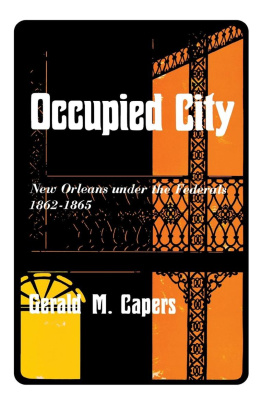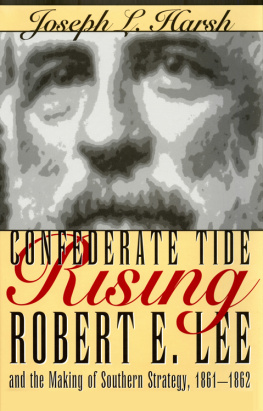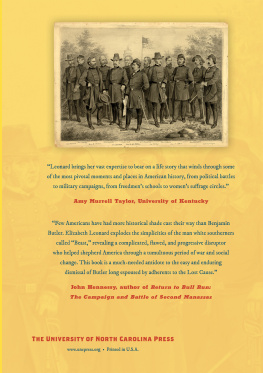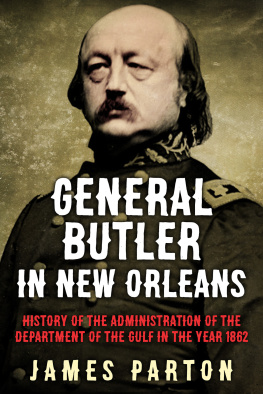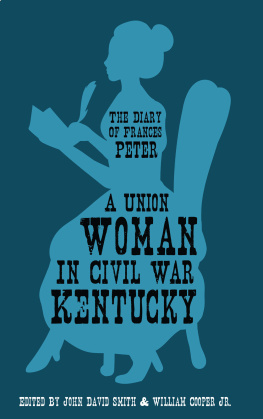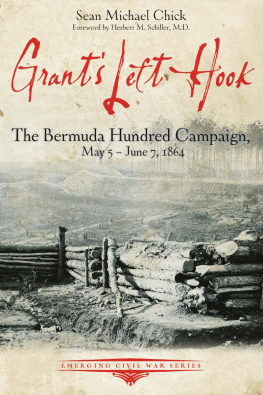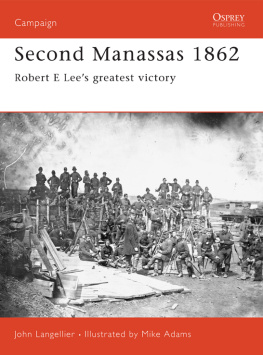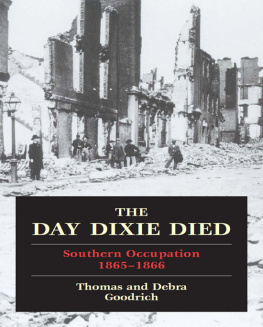PREFACE
LIKE MANY of my generation of southerners, I learned about the Civil War from my grandmothers, who were eyewitnesses to the ordeal. Anna Misroon (Capers) as a sixteen-year-old girl witnessed the firing on Sumter from her house on the Battery, and her silver was later confiscated by Shermans soldiers. Rachel Hutchinson (Deane), being some years older, suffered more acutely. Her husband Albert was one of the Louisianians wounded at Shiloh, and many years later he died from an infection caused by the bullet he carried in his leg. After the battle of Baton Rouge in August, 1862, she rode down a Yankee sentry in order to comfort her mortally wounded brother, Samuel. Despite my best efforts I was never able to convince either of them that Lincoln was a great man.
I have always regarded military history, whatever its appeal to the layman, as intellectually sterile. For a century southerners have made a fetish of the Civil War, using it to fulfill their penchant for self-pity and to justify their racial caste system. Brave men have often died for causes in which they believed; they should properly be commemorated for their courage. But this does not belie the basic fact that all wars, civil and national, are inhuman, barbaric, and stupid; or that the people of both South and North must share equally the responsibility for the tragedy of 1861. Unlike some of their descendants, many Confederate soldiers freely admitted that they were rebels; most of those who survived accepted the hard gage of battle and took up life where they had left it. Surely a century of commemoration of their valiant deeds is sufficient. Let us hope that with the orgy of the centennial the dead will at long last be laid quietly to rest.
In retrospect, life in New Orleans during the Civil War does not seem to the present generationdespite the rule of Beast Butleras dramatic as that in Washington and Richmond, which Margaret Leech and Alfred H. Bill have described so vividly. This impression is due to a basic contrast in the history of these three cities during the hostilities. Washington, though threatened, was never captured, and beleaguered Richmond did not fall until the end of the war. New Orleans, on the contrary, was taken at the start of the second year of the struggle, and it was never recaptured. From the viewpoint of those living in the 1860s, however, the New Orleans story was quite dramatic. Suspense there was just as great, for a good chance of its recapture existed even as late as 1864 when Banks led his unsuccessful campaign up the Red River.
I do not intend this as a book about the Civil War in the traditional sense, though it is so in point of time. What I have tried to do is to examine, in a specific instance, the problems of the conqueror and the response of an urban population to military occupation.
Professor Ralph Gabriel of Yale, on the faculty of the School of Military Government during World War II, summarized our national experience in military occupation in an incisive article in the American Historical Review, July, 1944. In 1860 we as a nation had carried out but one brief occupation of foreign territorythat of General Winfield Scott in Vera Cruz, Mexico in 1846. Scotts brilliantly successful performance was largely the result of his General Orders No. 20, laying down the rules for American martial law which won him the support of the Mexican people against Santa Anna. This order was largely the basis in our next conflict for the even more famous General Orders No. 100, published April 24, 1863, written by Francis Lieber and a board of officers.
But any historical study of our national experience with military occupation must concern itself equally with the other side of the story: instances in which Americans themselves fell under the rule of a conquering enemy. The British occupied several American cities during the Revolution, notably New York; yet by the 1860s the memory of that ordeal was dim, if not forgotten. New Orleans is the largest American city ever occupied by enemy forces for a considerable period.
For many periods in the history of individual American cities the sources are scanty, but for New Orleans in the 1860s they are plethoric and frequently redundant. In the location of these sources, and for certain conclusions about the occupation, I wish to express my indebtedness to two works in particular: Fred Harringtons biography of General Banks, and Elizabeth Doyles unpublished doctoral dissertation on civilian life in occupied New Orleans. I am under obligation, as well, to several of my Tulane colleagues for their critical reading of the manuscript: my wife Roberta, Albert Cowdrey, and Marguerite Bougere.
I am also indebted to the staffs of the following libraries for their assistance: the Howard Tilton Memorial Library at Tulane and the New Orleans Public Library; the Louisiana State University Library at Baton Rouge; the Sterling Library at Yale, the Houghton at Harvard, and the Essex Institute at Salem, Mass.; and to Dr. Philip M. Hamer of the National Archives. My research was facilitated by grants from the Research Council of Tulane University and the John Simon Guggenheim Foundation.
ONE | THE CRESCENT CITY ON THE EVE OF THE CIVIL WAR |
WHEN THE PELICAN FLAG of the Independent State of Louisiana was raised in New Orleans on January 27, 1861, it was the fourth flag to fly over the city. The Stars and Bars of the Confederate banner at the end of March was the fifth. From the founding of the city in 1718 until near the end of the Seven Years War, the Island of Orleans had belonged to France, and from 1762 to 1800, to Spain. Then Spain secretly returned it to Napoleon, who in turn sold it to the United States in 1803. Changes in national allegiance were an old story to Louisiana Creoles.
In the middle of the nineteenth century, residents of the Crescent City had reason to expect it to become the largest city in an America which was rapidly moving west. From less than 10,000 in 1803 when Jefferson bought it from France, the population of New Orleans had soared by 1840 to 102,000, making it third in rank in the entire nation. In that year it led the nation in value of exports, ahead even of New York; and it handled twice as much of the western produce exported as all other ports together. The tonnage at its wharves was more than double that of its rival on the Hudson. In the year of Lincolns election 3,500 steamboats docked at its wharves, an average of ten a day; its total trade, exports and imports, amounted to a stupendous $324,000,000. Louisiana banks ranked first in capital stock, deposits, and specie among the fifteen slaveholding states.1
This growth and wealth resulted from the richness of the great interior valley of the United States and from the Mississippi River which flows down its center. Located 120 miles from the mouth, between a crescent bend in the river and Lake Pontchartrain a few miles to the north, New Orleans became a transhipment point for all exports coming downstream. The mountain barrier of the Appalachians long gave New Orleans a monopoly of the commerce of the interior valley. The invention of the steamboat early in the century, by making it possible to ship goods up the river in quantity, cinched this monopoly, which lasted until the completion of the Erie Canal in 1825 and of the canals between the Ohio and the Great Lakes two decades later.

